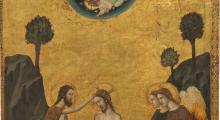Issued by the Catholic Center for Studies and Media - Jordan. Editor-in-chief Fr. Rif'at Bader - موقع أبونا abouna.org

Following is the homily of Most Rev. Archbishop Pierbattista Pizzaballa, Apostolic Administrator of the Latin Patriarchate of Jerusalem, for Easter 2020:
Dear brothers and sisters,
We have come to the end of this Holy Week, the most important of the weeks and certainly also the strangest of all.
We didn't have the solemnity we wanted. The limitations due to the pandemic, however, led us indirectly to reflect on what is essential to us. These days we have experienced in a new way the absence of normal relationships between us, the absence of the Eucharist, the absence of meeting our communities. Locked up in our homes and limited in movement, we have understood how important those things are that we’ve been denied: freedom of movement, school, work, participation in group life, time with friends and so on. It is true: frequently it happens that we learn to appreciate what we have once we lose it. And so, it was for these possibilities that we are now missing. But there is another absence, no less important, that we have known these days: the possibility of celebrating salvation. The failure to celebrate salvation during this Holy Triduum, in this context of fear and uncertainty, has made us even more aware of our fragility and our limitations.
In recent weeks, it’s become clear to us how fragile we are and how frail our social and institutional structures are. Struck by what is dearest to us, we have found that our human ingenuity, however acute and developed, does not guarantee salvation. The big questions about life and death, about who we are, arose again in our hearts. We understood that the word salvation is not only linked to the ability of science to solve the great problems of the moment (something we are all eager and grateful for anyway), but it is connected first of all with the mystery that indwells human nature, and that we cannot manage to possess completely. That’s why the impossibility to celebrate the mysteries of salvation during this week seemed still more difficult. Because for us this mystery is not an insoluble enigma, salvation is not a chimera. For us, the mystery of salvation has a name: “Christ, risen from the dead”, who “no longer dies; death no longer has power over him” (Rom. 6:9) and is now “seated at the right hand of God” (Col. 3,1). In the Holy Triduum, we celebrate this mystery and we experience it. At Easter, the risen Christ breaks into our poor lives and illuminates them with a new light. And right now, in a time when we feel a strong desire to shout out the common need for salvation, we are prevented from doing so. And so, we realize how much we miss celebrating the love that conquers every death. Of course, we know that He is the resurrection and the life and that whoever believes in Him, even if he dies, will live; we know that whoever lives and believes in him will not die forever (Cf. Jn 11:25–26).
And yet, in this moment of great difficulty and solitude, we perhaps feel more ours the words that Martha addressed to Jesus: “Lord, if you had been here, my brother would not have died!” (Jn 11:21). How this loneliness weighs on us, how tiring it is to be guided by Him on these unknown paths!
Well, here we now, in front of this empty tomb, want to cry out: Lord, you have not abandoned us in the arms of death. The grave is empty. You are no longer locked up in the sepulcher, because we know that You Lord are alive and are here, with us. Your love sustains us, illuminates our existence, comforts our fragile hopes.
That is what we celebrate today: not only the triumph of life over death, but of the love of God, which comes not only to die with us, to die for us, but also to bring us together with Him, beyond death. God the Father does not abandon the man Jesus in death but saves Him, gives Him a life that is forever and calls us to this same life.
The evangelist John begins the account of the resurrection with a temporal annotation: “The first day of the week” (Jn 20:1). It is day one, the new beginning, the beginning of a new creation.
On this first day of the new creation, Mary of Magdala and Peter and John, called by her, go to the sepulcher. They who saw their loved one die, who encountered death. They thought that this death could put an end to days, that there could no longer be another day, that there would no longer be any “one” day. All three do the same things: they go (v. 1), they run (v. 4) and they look (v. 6.8). These are the verbs of those who are still looking, despite everything. They do not know what to look for, because only one thing is now certain for them: Jesus is dead, and he will no longer be able to meet Him.
They see the burial cloths with which Jesus had been buried, completely emptied of the body they wrapped. Jesus abandoned them, he didn’t remain there, He wasn’t a prisoner of it. The burial cloths are signs of the power of death and are folded back on themselves. So, they have become the sign that “death no longer has power over him”. And thanks to those signs, they understand and believe. “In fact, they had not yet understood the Scripture that he was to rise from the dead” (Jn 20: 9). That verb, “had to”, “it was necessary”, Jesus had used it to tell the necessity of His passion so that the Scriptures would be fulfilled. Now the evangelist uses it to speak of the resurrection.
Those Scriptures that tell the plan of God and His love for man, those Scriptures that begin with the first day of a week in which God creates the world, those Scriptures attest that the work of God, His Glory, would be accomplished by going through a painful passageway, like a birth, from which life would be reborn. The story of the passion, therefore, documents that nothing can stop love. Those Scriptures tell us that our death, what appears to us in this time so close and so painful, can be part of this same mystery, it may not be the end of days.
There is something stronger than death. In faith, it is the place where the Lord comes, where He visits us, where He takes us beyond. Paradoxically, it becomes the place where we, more than anywhere else, can know the power of His love, where we can experience His faithfulness.
But, like the disciples, we too need signs that announce this salvation to us, we need to touch it, to experience it. And what are these signs that testify to the resurrection today? We have the empty Tomb in front of us. This is certainly a sign. But where are the burial cloths folded on themselves? Where are the gestures that, like the cloths two thousand years ago, make it possible for us to see and believe that Christ truly is risen, that he is the Living One among us? Where are the signs that give us hope?
First of all, we must do like the two disciples of the Gospel: run to look for the Risen One. We will not find signs if we do not first seek them, and we will not meet the Risen One if we do not come out of our little cenacles, where fear has locked us up. We need to abandon our human security, the presumption that we don't need to be saved, and to rush out, to meet Him. Otherwise, every effort will be in vain.
Where do we meet him? Wherever there is a person who will freely give something of himself for the other, salvation is announced there. Where someone will bend and pour balm on the wounds of others, the presence of the living Christ is celebrated there. Where our community, the Church, will know how to bring and speak a word of consolation, comfort and hope, there is the miracle of the new creation that the resurrection of Christ has begun. We announce that the risen Christ is our hope when with our gestures of love and sharing we know how to give meaning and perspective to the existence, even the most painful; when we testify with concrete gestures that life makes sense if it opens itself to affections, to love, and when our actions and our works are entrusted to His charity and not to our pride.
We are too folded back on our fears, and we are too afraid of what is happening. Instead, we must shout out loud that tribulation, anguish, persecution, hunger, nakedness, danger, or the sword will not separate us from the love of Christ. That in all these things we are victors, and nothing can ever separate us from him, not even death (cf. Rom 8: 35-37).
If we search for them, then, we will find the signs of His presence, because everywhere in the world even today some have come out of their upper room to break their bread for the love of every man. Let us ask it also for us, for our communities that are sometimes so folded up and closed in on themselves. We ask for the grace and strength to look up and open our eyes to see the signs of the Risen One among us.
Do we believe this? Are we convinced that the Risen Christ lives in us and in our community? Do we believe that even in the deepest folds of our sin the strength of His forgiveness has come? Do we believe that the infidelities and betrayals of ourselves and our community have been overcome by a love that has no boundaries? Have we experienced it?
Faith does not erase the dramatic character of existence but opens our eyes and hearts to a perspective of salvation, of eternal life, of joy. It is what we celebrate on Easter day and it is what we want to celebrate with life. Therefore, let the wide-open sepulcher of Christ open our sepulchers too!
It is what we ask for the Church and every man.
+Pierbattista







